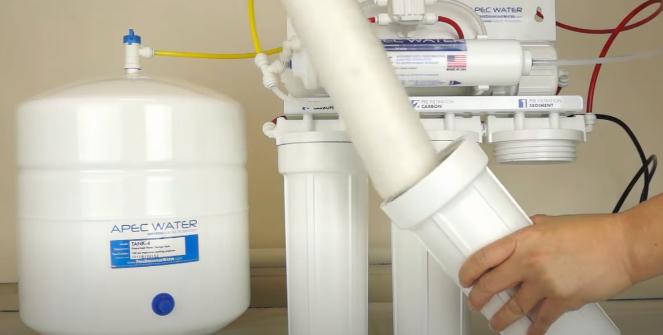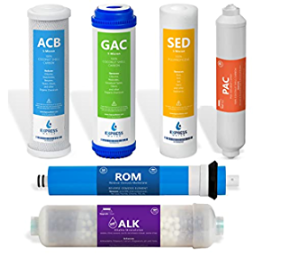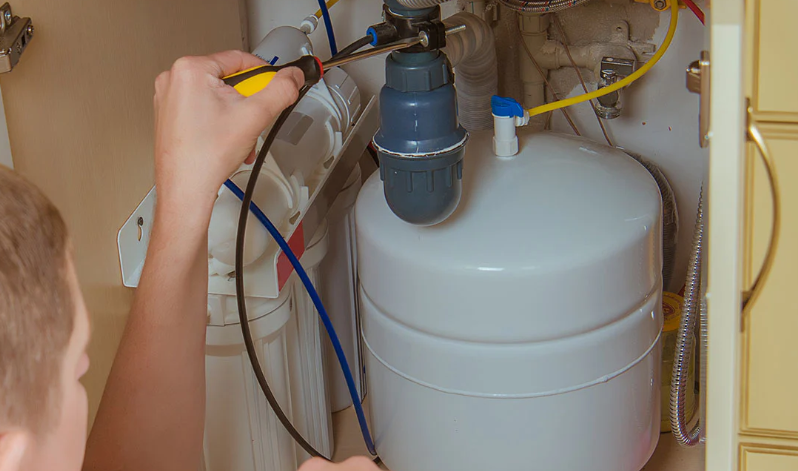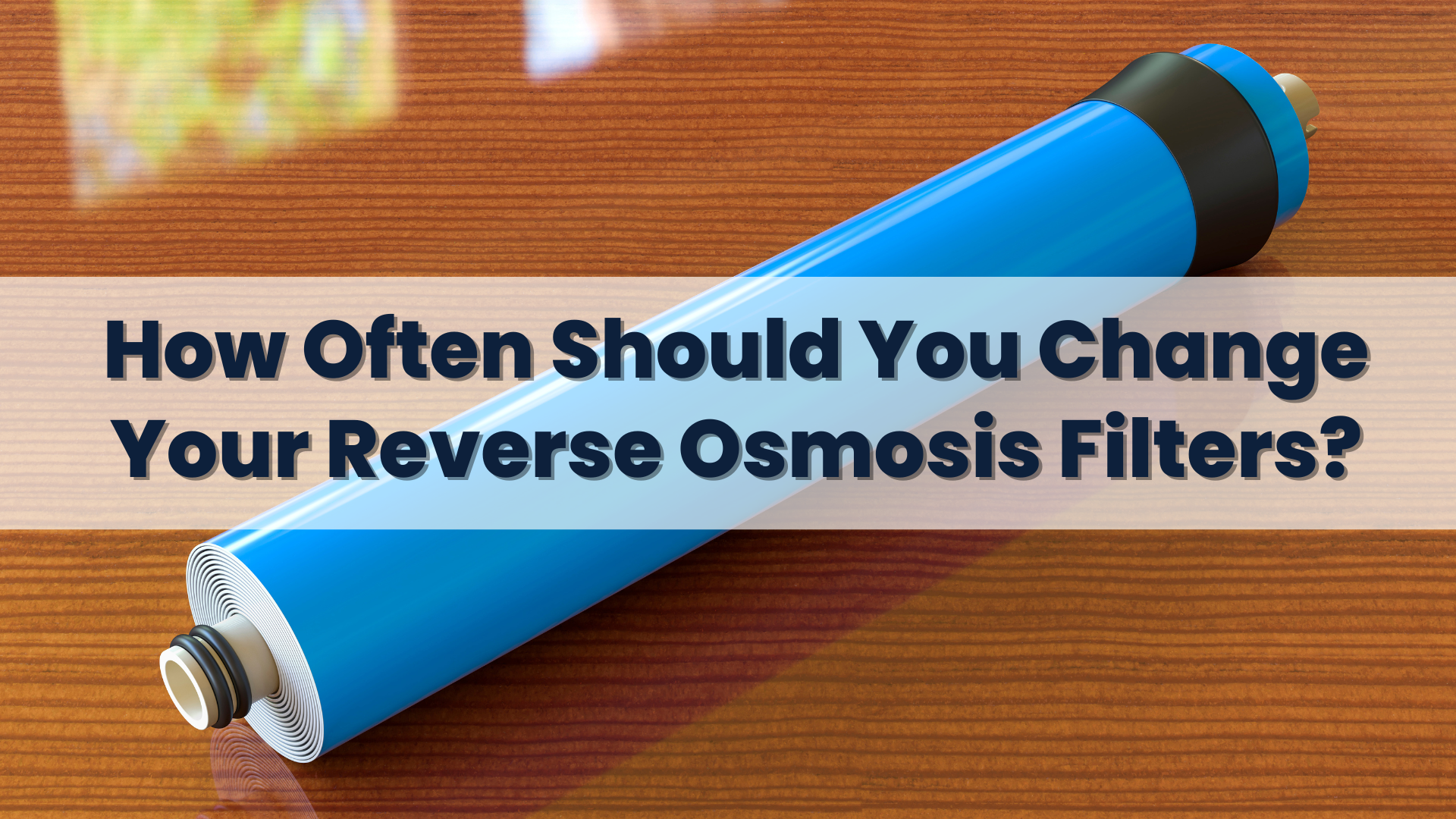Reverse osmosis (RO) is a popular water filtration process that removes impurities and contaminants from the water. With regular maintenance, RO systems can provide clean and safe drinking water for years. One of the most important parts of maintaining your reverse osmosis system is changing its filters at the right intervals. So how often should you change your reverse osmosis filters?
Why Reverse Osmosis Filters Need To Be Changed Regularly?

Reverse osmosis (RO) filters are designed to remove a wide range of impurities from your drinking water. Over time, however, the filters can become blocked with sediment and other particles and will need to be replaced to keep your water clean. This is why it’s important to change them regularly – typically every 6-12 months, depending on the type of filter you have.
The frequency at which you need to change your RO filters depends on several factors, including the water quality in your area and the amount of usage your system gets. If you notice that your water is starting to look or taste different, this could indicate that it’s time to replace the filters. It’s also a good idea to check and clean your system regularly, as this can extend the life of the filters and help ensure your water remains safe to drink.
Why Some Homes Should Change Their Reverse Osmosis Filters More Or Less Often Than Others.
- How many people use reverse osmosis water in the home: Reverse osmosis is becoming increasingly popular for producing cleaner and better-tasting drinking water in the home. According to a survey conducted by the National Sanitation Foundation, about 24% of American households now have some form of reverse osmosis system installed.
- Pre-reverse osmosis system water treatment: For those who have a reverse osmosis system, it is important to regularly change the filters to ensure that your water is pure and free from contaminants. The pre-filters (sediment filter, activated carbon filter) will need to be changed every 6 to 12 months, depending on the quality of your incoming water supply.
- Amount of Turbidity in the water: This is the most important factor to consider when deciding how often “you” should change your reverse osmosis filters. Turbidity is a measure of suspended matter in water, and it can vary from area to area. If there is high turbidity in the water supply, then the filters will need to be changed more frequently than if there is low turbidity.

Amount of Turbidity in the water - Well water or pre-treated municipal water: the frequency of changing the filters in a reverse osmosis system depends on the quality of your water source. If you are using well water or pre-treated municipal water, then you should change your filters at least every 3 months. The sediment pre-filter should be replaced every 6 months.
- Type of filters used in your reverse osmosis system: The type of filter used in your reverse osmosis system will affect how often you need to change it. Generally speaking, if your system uses a sediment and carbon filter, these filters should be changed every six months to ensure that the water is clean and free from impurities. If your reverse osmosis system also has an additional membrane filter, you should change this every 2-3 years depending on the usage and water quality.
Signs Your RO Filters Need Changing

- Change in water taste or odour: If you start to notice a change in the taste or smell of your water, it could be a sign that your filters need replacing.
- Decrease in water flow rate: A decrease in water flow rate is one of the first signs that your reverse osmosis filters need to be changed. If you notice a decrease in water pressure or flow rate, it’s time to replace your filters.
- Increase in TDS levels: In addition to changing your reverse osmosis filters regularly, it is important to keep an eye on the TDS (total dissolved solids) levels in your water. When the TDS reading increases, you should change the membrane filter immediately. This will prevent your system from becoming overwhelmed and producing lower-quality water. It will also help keep sediment and particles from clogging the system.
- Change in colour or appearance of the water: Another sign that it is time to change your reverse osmosis filters is if the colour or appearance of the water changes. This could be due to sediment, algae, and other particles in the water. If you notice a difference in colour or taste, it may be time to replace the filter.
How Often To Change Reverse Osmosis Filters? (Light Usage)

If you use your reverse osmosis water filtration system lightly, meaning that it is used only occasionally and doesn’t require a large amount of water every day, then the filters will usually last longer than average. Generally speaking, you should change the pre-filters once per year and the carbon filter once every two years. However, if you notice a decrease in water flow or the taste of your filtered water is not as good as it used to be, then it might be time to change the filters.
How Often To Change Reverse Osmosis Filters? (Moderate Usage)

If you are using your reverse osmosis filtering system on a moderate basis, the industry standard is to change out the filters every 6-12 months. This will depend on how much water you use and how often. For example, if you’re drinking RO-filtered water as your primary source of hydration, it’s best to change the filters every 6 months. If you’re using it more occasionally, such as for special occasions or to filter larger batches of water in one go, then changing them out yearly should be fine.
How Often To Change Reverse Osmosis Filters? (Heavy Usage)
For households that use reverse osmosis (RO) filters heavily, the filter should be changed every six months. This is to ensure that your water quality remains pristine and there are no impurities or contaminants in the water. The RO filter works by removing any sediment from the water, which can accumulate over time and decrease its effectiveness if left unchecked.
If you use the RO filter more heavily than usual, it is recommended that you change the filters every 3-4 months to keep your water quality at its best. It’s important to remember that even if you are not using the filter heavily, regular maintenance and replacement of parts will help extend the life of your unit and give you better water quality.
Do You Need To Change All Of The Reverse Osmosis Filters Every Time?
Not necessarily. Depending on the quality of your water and how often you use it, some filters may last longer than others. Generally speaking, the sediment filter should be changed every six months to one year. The carbon filter should be changed every two years, and the post-filter can typically last up to three or four years. However, if you notice a decrease in water quality, it may be time to change any of these filters sooner.
It is also important to note that reverse osmosis systems vary by brand and model. Therefore, it pays to consult with the manufacturer or retailer for suggested filter-change intervals for your specific system. Doing so will help ensure you get the most out of your reverse osmosis system and that drinking water quality is always at its best.
What Filters Need To Be Changed And How Often?

The filters in a reverse osmosis system need to be changed at different intervals depending on the type of filter. Pre-filters are generally changed every 6-12 months, while the membrane and post-filter should be changed every 2-3 years. It’s important to follow the manufacturer’s recommendations when it comes to changing your filters as they may vary slightly. It’s also a good idea to keep track of when the filters were last changed so you can know when it’s time to change them again.
How To Know That You’re Getting The Right Filters?

When it comes to the appropriate filters for your reverse osmosis system, there is no one-size-fits-all answer. Different systems require different types of filters and need to be replaced at different intervals. To make sure that you’re getting the right filter for your system and replacing them at the right time, here are a few tips.
- Read the manufacturer’s instructions for your system and note what type of filter is needed and how often to replace it. This is the most reliable source of information on your specific system and will help you make sure that you get the right filter and change it at the right interval.
- Keep track of when you replace your filters. Make a note on the calendar or put a reminder in your phone so that you can easily remember when it’s time to change them out.
- If you are unsure about what type of filter to use for your system, don’t hesitate to contact the manufacturer directly. They should be able to provide you with the right information and make sure that you’re getting the right filter for your system.
- If your water tastes funny or has a strange smell to it, this could be an indication that it’s time to change out the filter in your reverse osmosis system.
How Much Do Filters For My Reverse Osmosis System Cost?
3-Stage Reverse Osmosis Replacement Filter: $24.95 – $49.95
It’s important to note that you should always refer to the instruction manual provided with your reverse osmosis system in order to determine exact filter replacement instructions, as well as types and frequencies of filter changes.
4-Stage Reverse Osmosis Replacement Filter: 45-90$
It is recommended to change the filters in a 4-stage reverse osmosis system every 6 months. This will ensure that your drinking water remains free from any contaminants and impurities. In order to keep up with changing your filters, you can purchase replacement filter sets for approximately 45-90$.
5-Stage Reverse Osmosis Replacement Filter: 55-110$
For a 5-stage reverse osmosis system, it is recommended to replace the filters every 6 months. This will help ensure maximum performance of your RO unit and yield better water quality from your tap. The cost for replacing these filters can vary from 55 to 110 dollars, depending on what type of filter you are buying. It is important to make sure you are buying the correct filters for your particular model. The cost of replacement filters can be avoided by regularly cleaning and servicing the unit, but it is still advisable to replace them every 6 months.
Signs That You May Need To Change Your Reverse Osmosis Filters Sooner
- Poor Water Pressure From RO Faucet: If you notice the water pressure from your reverse osmosis faucet is lower than usual, it could be an indication that your filters need to be changed.

Poor Water Pressure - Poor Tasting Water From Your Reverse Osmosis System: If you are experiencing poor-tasting water from your reverse osmosis system, there is a good chance that the filters need to be changed. The efficiency and effectiveness of the reverse osmosis process can be drastically reduced if any of the components—the sediment filter, carbon filter or membrane—are not functioning optimally.
- Reverse Osmosis storage tank not filling: If you notice that your reverse osmosis storage tank is not filling up over the day, it may be time to change your filters. This could indicate that something is blocking them and preventing water from entering the system. Replace all filters accordingly and check for any clogs or other blockages in the system.

Reverse Osmosis storage tank
Do Reverse Osmosis Filters Need To Be Changed Less Often With Municipal Water?

Yes, if you are using a reverse osmosis system with municipal water, then the filters will likely need to be changed less frequently than those connected to private wells. Municipal water systems are generally treated more consistently and thoroughly than well water, so there is typically less sediment and bacteria present in it. However, even when using municipal water, it’s still important to inspect and monitor your filters on a regular basis and change them whenever they become clogged or dirty. This will ensure that the water produced by your reverse osmosis system is clean, safe, and free of impurities.
Do You Need To Change Reverse Osmosis Filters More Often With Hard Water?
Yes, if your home has hard water, you may need to change your reverse osmosis filters more often. Hard water is known for having high levels of minerals like calcium and magnesium that can clog the filter faster than normal. If this is the case, it’s best to check your filter every three months or so to ensure it’s working properly and to replace it if necessary. Additionally, you may also need to change the reverse osmosis membrane more frequently as well. In general, most membranes should be changed once a year or two for optimal performance.
In what Order Do RO Filters Go In?
The order in which you change your reverse osmosis filters depends on the type of system that you have. Generally, most systems will require you to change the sediment filter first, followed by the carbon filter and finally the membrane filter. The frequency of RO filter changes may vary depending on water usage and other factors such as sediment levels or chlorine in the water.
FAQs
Can I reuse RO filters?
No, RO filters should not be reused. They are designed to be used once and then disposed of. It is important to replace the RO filter every 6-12 months for optimal performance. During this time, sediment, dirt, and other contaminants can build up on the filter, reducing its effectiveness.
Are all RO filters the same?
No. Depending on the type of reverse osmosis system you have, your filters may need to be changed more or less frequently. Generally speaking, for a standard 4-stage RO system, pre-filters should be changed every 6 months, carbon block post-filters every 12 months and membranes every 2-3 years.
What is the best way to dispose of used filters?
When it comes time to change the reverse osmosis filters in your system, you should also think about how you will dispose of them. Used filters can contain bacteria and other contaminants that can be hazardous if not disposed of properly. To ensure safety, most experts recommend disposing of used filters in a sealed container such as a plastic bag or waste bin, and then disposing them in the trash.
Can I install an RO system without professional help?
Yes, you can install an RO system without professional help. However, it is important to consider the complexity of the task before attempting a DIY installation. This is especially true if your water pressure exceeds 80 psi or if a pressurized storage tank is involved. Depending on these factors, some components may need to be sized differently than what comes standard
Can You Clean And Reuse Reverse Osmosis Filters Instead Of Changing Them?
No, you should not attempt to clean reverse osmosis filters and reuse them. This practice is not recommended as the filter material can break down and not be able to properly filter out contaminants. Additionally, cleaning the filter could potentially introduce micro-organisms into the system that can quickly contaminate your water supply. It is best to replace with new filters instead.
Conclusion
Reverse osmosis systems require regular maintenance to keep them functioning properly and efficiently. To ensure your system is running optimally, it is important to change the filters on a regular basis. Generally speaking, you should replace filters every 6-12 months or as recommended by the manufacturer. If you notice any changes in water pressure or taste, it is a good idea to check the filters and replace them as needed. Ultimately, maintaining your system with regular filter changes will help ensure you continue to get high-quality water from your reverse osmosis system.

Meet Nigel Pearson, a water filter enthusiast with a background in molecular biology. He’s all about making sure we have safe drinking water, and he’s got a bunch of interests that tie into it – think science, technology, plants, and genetics.
Imagine someone who loves learning how living things work on a tiny level – that’s Nigel. He’s studied how genes and molecules come together to make life happen. But what really caught his attention is how living things adapt to their surroundings.
Nigel didn’t stop at just learning about this stuff – he decided to use his smarts to help solve a big problem: how to get clean drinking water for everyone. He writes cool blog posts that explain tricky science things in simple words. You’ll get to read about stuff like how plants can help clean water, or how new inventions are changing the way we purify water.
But it’s not just about science and tech for Nigel. He truly cares about people and their need for safe water. Every blog post he writes shows how much he wants to make a difference. By sharing his knowledge, she wants to get more people thinking and caring about clean drinking water.
